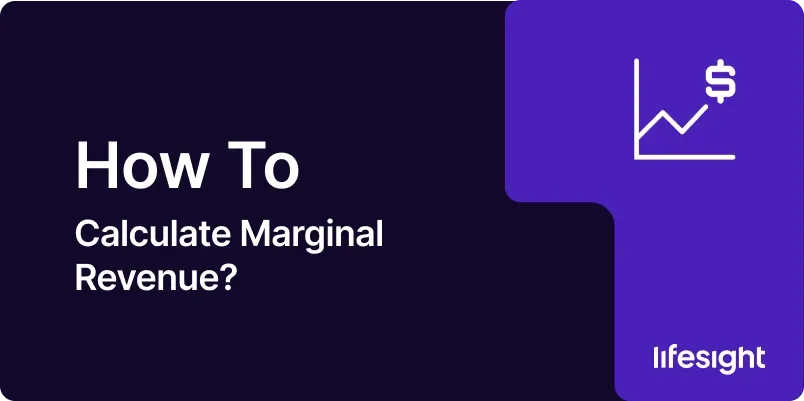
In the dynamic world of marketing and advertising, understanding the financial impact of your strategies is crucial. One key metric that can help you make informed decisions about pricing, production, and promotional efforts is marginal revenue. This guide will walk you through the process of calculating marginal revenue, its importance in marketing decisions, and how to apply this knowledge to optimize your advertising campaigns.
What is Marginal Revenue?
Before we dive into the calculations, let’s define marginal revenue:
Marginal revenue is the additional revenue generated from selling one more unit of a product or service. In other words, it’s the change in total revenue that results from selling one additional unit.
For marketers and advertisers, understanding marginal revenue is crucial because it helps in:
- Determining optimal pricing strategies
- Deciding whether to increase production or advertising efforts
- Evaluating the effectiveness of promotional campaigns
- Maximizing profitability of product lines
The Basic Formula for Marginal Revenue
The formula for calculating marginal revenue is straightforward:
Marginal Revenue = Change in Total Revenue / Change in Quantity Sold
Or, in mathematical notation:
MR = ΔTR / ΔQ
Where: MR = Marginal Revenue ΔTR = Change in Total Revenue ΔQ = Change in Quantity Sold
Step-by-Step Guide to Calculating Marginal Revenue
Let’s break down the process of calculating marginal revenue with a practical example relevant to marketing and advertising professionals.
Step 1: Gather Your Data
First, you need to collect the necessary data:
- Current quantity sold
- Current total revenue
- New quantity sold (after increase)
- New total revenue (after increase)
For example, let’s say you’re running a digital marketing campaign for a software product:
- Current monthly subscriptions: 1000
- Current monthly revenue: $50,000
- After a new ad campaign, subscriptions increase to 1100
- New monthly revenue: $54,000
Step 2: Calculate the Change in Quantity
Subtract the original quantity from the new quantity:
ΔQ = 1100 – 1000 = 100
Step 3: Calculate the Change in Total Revenue
Subtract the original revenue from the new revenue:
ΔTR = $54,000 – $50,000 = $4,000
Step 4: Apply the Marginal Revenue Formula
Now, let’s use our formula:
MR = $4,000 / 100 = $40
This means that each additional subscription generated $40 in marginal revenue.
Interpreting Marginal Revenue in Marketing Contexts
Now that we’ve calculated marginal revenue, what does this mean for your marketing and advertising strategies?
- Pricing Decisions: If your marginal revenue is higher than your marginal cost (the cost of producing one more unit), it might be profitable to increase production and step up your marketing efforts.
- Ad Campaign Efficiency: By comparing the marginal revenue to the cost of acquiring each new customer through your ad campaign, you can determine if the campaign is profitable.
- Scaling Decisions: If marginal revenue is declining, it might indicate market saturation, suggesting you need to explore new markets or adjust your marketing strategy.
- Product Line Optimization: By calculating marginal revenue for different products, you can decide which ones to focus your marketing budget on.
Real-World Applications in Marketing and Advertising
Let’s explore some specific scenarios where calculating marginal revenue can inform your marketing decisions:
1. A/B Testing Ad Campaigns
Suppose you’re running two different ad campaigns (A and B) for the same product:
Campaign A:
- Cost: $5,000
- New Customers: 200
- Additional Revenue: $10,000
Campaign B:
- Cost: $7,000
- New Customers: 300
- Additional Revenue: $16,500
Calculating marginal revenue for each campaign:
Campaign A: MR = $10,000 / 200 = $50 per customer Campaign B: MR = $16,500 / 300 = $55 per customer
While Campaign B has a higher cost, it also generates higher marginal revenue per customer, making it potentially more profitable if you can scale it effectively.
2. Optimizing Email Marketing Frequency
You’re testing different email frequencies for your marketing newsletter:
Weekly Emails:
- Subscribers: 10,000
- Revenue: $50,000
Daily Emails:
- Subscribers: 9,500 (some unsubscribed due to frequency)
- Revenue: $57,000
Calculating marginal revenue:
MR = ($57,000 – $50,000) / (9,500 – 10,000) = $-1,400 / -500 = $28 per subscriber
Despite losing some subscribers, the increased frequency led to higher marginal revenue per remaining subscriber, suggesting it might be a profitable strategy if the trend continues.
3. Evaluating Influencer Partnerships
You’re considering partnering with two influencers:
Influencer A:
- Cost: $10,000
- Estimated New Customers: 500
- Estimated Additional Revenue: $30,000
Influencer B:
- Cost: $15,000
- Estimated New Customers: 800
- Estimated Additional Revenue: $52,000
Calculating marginal revenue:
Influencer A: MR = $30,000 / 500 = $60 per customer Influencer B: MR = $52,000 / 800 = $65 per customer
While Influencer B has a higher cost, they also generate higher marginal revenue per customer, potentially making them the better choice for your campaign.
Advanced Considerations
As you become more comfortable with marginal revenue calculations, consider these advanced concepts:
1. Diminishing Marginal Revenue
In many cases, marginal revenue tends to decrease as quantity increases. This concept, known as diminishing marginal revenue, is crucial for marketers to understand:
- It may indicate market saturation
- It suggests a need for new market segments or product innovations
- It can inform decisions about when to shift marketing focus to other products or services
2. Price Elasticity of Demand
Marginal revenue is closely related to the price elasticity of demand. Understanding this relationship can help you:
- Predict how price changes will affect revenue
- Determine optimal pricing strategies for different market segments
- Adjust your marketing messages to emphasize value when demand is elastic
3. Marginal Revenue Product (MRP) in Advertising
MRP is the additional revenue generated by employing one more unit of a factor of production. In advertising, this could be:
- One more ad placement
- One more hour of a marketing professional’s time
- One more dollar spent on a PPC campaign
Calculating MRP can help you optimize your resource allocation in marketing efforts.
Common Pitfalls to Avoid
When working with marginal revenue in marketing contexts, watch out for these common mistakes:
- Ignoring Fixed Costs: While marginal revenue focuses on variable costs, don’t forget about fixed costs when making overall profitability assessments.
- Assuming Linearity: Marginal revenue often doesn’t change in a linear fashion. Be prepared to recalculate at different quantity levels.
- Overlooking Quality Changes: Sometimes, scaling up production or services can lead to quality changes that affect customer perception and willingness to pay.
- Neglecting Long-Term Effects: A strategy that increases marginal revenue in the short term might have negative long-term consequences on brand perception or customer loyalty.
Tools for Marginal Revenue Analysis
Several tools can assist you in calculating and analyzing marginal revenue:
- Spreadsheet Software: Excel or Google Sheets are excellent for basic calculations and creating visual representations of your data.
- Business Intelligence Tools: Platforms like Tableau or Power BI can help you visualize marginal revenue trends across different products or campaigns.
- Marketing Analytics Software: Tools like HubSpot or Salesforce Marketing Cloud often include features for revenue analysis.
- Custom Dashboards: Many agencies create custom dashboards that integrate data from various sources to calculate and display marginal revenue metrics.
Conclusion: Leveraging Marginal Revenue in Your Marketing Strategy
Understanding and effectively using marginal revenue calculations can significantly enhance your marketing and advertising decision-making processes. By knowing the additional revenue generated from each extra unit sold, you can:
- Fine-tune your pricing strategies
- Optimize your advertising spend
- Make informed decisions about scaling your marketing efforts
- Identify the most profitable products or services to focus on
Remember, while marginal revenue is a powerful tool, it should be used in conjunction with other metrics and considerations. Factors like brand equity, customer lifetime value, and market positioning all play crucial roles in a comprehensive marketing strategy.
As you continue to refine your approach to calculating and applying marginal revenue insights, you’ll develop a more nuanced understanding of your market, your customers, and the true impact of your marketing efforts. This knowledge will empower you to create more effective, data-driven marketing campaigns that not only drive sales but also maximize profitability.
So, the next time you’re planning a marketing campaign, considering a price change, or evaluating the success of an advertising effort, take a moment to calculate the marginal revenue. It might just provide the insight you need to take your marketing strategy to the next level!
Free essential resources for success
Discover more from Lifesight















